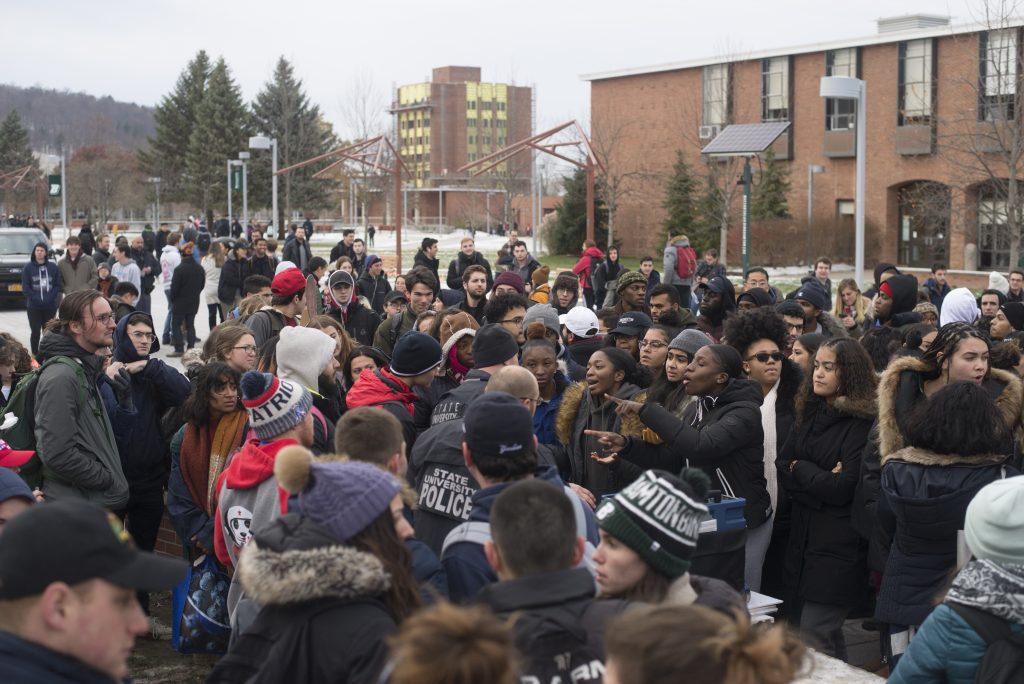
Needless to say, there has been a lot of political action on campus the past few weeks. New students must be overwhelmed by the pressure to take sides. Older students may remember some tense times in the past few years, but with breaks they seem so distant from each other; it’s easy to forget. Portrayals of the recent protests as “politically correct culture” cannot be further from the truth. Binghamton University has a long history of student activism that should continue for years to come.
There were three major protests between Nov. 14 and Nov. 21 of this year. About 200 students spontaneously protested and shut down a Turning Point USA table on the Spine. Just four days later, Arthur Laffer left an on-campus event he was meant to speak at after students and community activists protested it, leading to two arrests. Then, three days later, nine people, some of whom were BU students, were arrested at the Broome County Legislative Chamber for protesting a proposed law that would allow police to arrest those they deemed to be “annoying.” Full disclosure, I was at the last two protests and witnessed these events myself.
In just one week, these three major protests had the entire campus talking — and this is just what’s on campus and relevant to students. Binghamton community organizations like Progressive Leaders Of Tomorrow (PLOT) and Justice and Unity for the Southern Tier (JUST) stand up against oppressive structures in the Southern Tier, sometimes protesting with students like they did at the Broome County Legislature protests.
Although these protests may seem unexpected to some, student advocacy is not new on campus. As far back as 1986, students protested to end BU contracts with companies that did business in apartheid-era South Africa. Students in 2016 picketed outside of the Couper Administration Building, looking to ban Reynolds Consumer Products from the dining halls because of exploitative factory conditions. Students occupied the Couper Administration Building for 15 days in 2017 to protest the planned blue lights initiative, which would have placed blue light phones and street cameras in Binghamton’s West Side, a heavily student-populated neighborhood. Progressive groups and other student protesters saw it as adding law enforcement in an already over-policed community.
It’s also not as if these protests sparked from nothing. Students, particularly students of color, face harassment on and off campus, and are met with mostly lackluster responses from the police and the University. For example, a sit-in was held in 2017 to demand support from BU officials when members of X-Fact’r Step Team were harassed on the West Side. That same year, when racist graffiti was found in Newing College, Pipe Dream’s own editorial board called out the University for its tepid response. These are just two examples which demonstrate the reasons students have felt alienated and unheard by the University for a while.
So what was accomplished in these most recent protests? Laffer decided not to speak when faced with criticism. The vote on the annoyance law was postponed until Dec. 19, and after the meeting at the Broome County Legislature commenced, they voted to remove the word “annoying” from the law, leaving just “alarming” and “threatening.” Looking at BU’s history, progressive movements clearly have a history of getting things done.
This is all to say that activism at BU has a strong history of meaningful results. Students have been justifiably angry for a long time and protests are an expression of that. It may not seem like you can do something major, but companies lost their business with BU in 1986. Decry progressive movements all you want, but they got the wording of the police bill changed this semester. And if it’s this direct action that is getting things done, students should and will hold this lesson until next semester, and the rest of their lives.
Michael Levinstein is a member of BU Progressives and a senior double-majoring in political science and economics.



